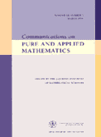
COMMUNICATIONS ON PURE AND APPLIED MATHEMATICS
Scope & Guideline
Connecting Theoretical Rigor with Practical Solutions
Introduction
Aims and Scopes
- Pure Mathematics:
The journal covers a wide range of topics within pure mathematics, including but not limited to algebra, geometry, analysis, and topology. It seeks to advance theoretical frameworks and present new mathematical concepts. - Applied Mathematics:
It emphasizes the application of mathematical techniques to solve real-world problems across various fields, including physics, engineering, and economics. This includes the development of models and numerical methods. - Interdisciplinary Research:
The journal promotes interdisciplinary studies that utilize mathematical techniques in other scientific domains, such as biology, finance, and computer science. This fosters collaboration between mathematicians and practitioners in other fields. - Numerical Analysis and Computational Mathematics:
Research that focuses on numerical methods and computational algorithms is a core area, aiming to improve the efficacy and efficiency of mathematical computations. - Stochastic Processes and Statistical Mechanics:
The journal also delves into stochastic processes, statistical mechanics, and their applications, highlighting the interplay between randomness and mathematical modeling. - Geometric Analysis and Differential Equations:
The exploration of geometric structures through differential equations is a prominent theme, often bridging pure and applied mathematics.
Trending and Emerging
- Nonlinear Partial Differential Equations (PDEs):
There is a notable increase in studies focusing on nonlinear PDEs, particularly in relation to fluid dynamics, free boundary problems, and phase transitions, indicating a growing interest in complex systems. - Stochastic Analysis and Applications:
The rise of stochastic processes and their applications in various fields, including finance and statistical mechanics, is becoming more prominent, reflecting a broader interdisciplinary approach. - Machine Learning and Data Science:
Research intersecting mathematics with machine learning and data science is rapidly emerging, emphasizing the importance of mathematical foundations in developing algorithms and understanding data patterns. - Geometric Measure Theory:
An increase in publications related to geometric measure theory indicates its relevance in understanding complex geometrical structures and their applications in various mathematical contexts. - Quantum Mathematics and Quantum Information:
Emerging themes in quantum mathematics and its applications in quantum information theory are gaining traction, reflecting advancements in both theoretical and practical aspects of quantum computing.
Declining or Waning
- Traditional Algebraic Structures:
Topics centered around classical algebraic structures, such as group theory and ring theory, have seen reduced publication frequency. This may indicate a shift towards more applied frameworks or computational approaches. - Elementary Number Theory:
Research in elementary number theory has been less prevalent, possibly overshadowed by more complex applications of number theory in cryptography and coding theory. - Classical Geometry:
The focus on classical geometric problems has diminished, as researchers increasingly turn to computational and applied geometric techniques, reflecting a broader trend towards practical applications. - Basic Statistical Methods:
The publication of papers on basic statistical methods has decreased, likely in favor of more sophisticated statistical models and machine learning applications. - Deterministic Dynamical Systems:
Research on deterministic dynamical systems appears to be waning, as stochastic models gain more attention for their applicability in real-world scenarios.
Similar Journals

Journal of Siberian Federal University-Mathematics & Physics
Fostering Academic Excellence in Siberia and BeyondJournal of Siberian Federal University-Mathematics & Physics, published by the Siberian Federal University, is an esteemed academic journal dedicated to the fields of mathematics and physics. With an ISSN of 1997-1397 and an E-ISSN of 2313-6022, this journal aims to foster innovative research and discourse by providing a platform for the dissemination of high-quality studies and advancements in these disciplines. While the journal is categorized in the third quartile (Q3) for both mathematics and physics as of 2023, it serves as a vital resource for researchers, professionals, and students seeking insights and developments within the Russian educational context and beyond. The journal supports an open access model, enhancing the visibility and accessibility of its content. With its publication horizon set from 2014 to 2024, the journal continues to contribute to the global body of knowledge, making it relevant for those engaged in the pursuit of academic excellence.

DOKLADY MATHEMATICS
Exploring Innovations in Mathematics Since 1996DOKLADY MATHEMATICS is a prestigious journal published by MAIK NAUKA/INTERPERIODICA/SPRINGER, recognized for its significant contributions to the field of mathematics. Since its inception in 1996, the journal has been delivering high-quality research articles, fostering advancement in diverse areas of mathematical sciences. With an ISSN of 1064-5624 and an E-ISSN of 1531-8362, it has established itself within the academic community and holds a respectable Q2 quartile ranking in Mathematics (miscellaneous), indicating its relevance and influence. Although it does not operate under an open-access model, the journal remains an invaluable resource for researchers, professionals, and students, propelling innovation and scholarship in mathematics until 2024. The Scopus ranking situates it at rank #254 out of 399 in the Mathematics General category, showcasing its position within the broader landscape of mathematical journals. This journal is essential for those aiming to stay abreast of the latest findings and theoretical advancements in the mathematics domain.
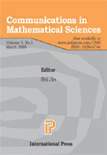
Communications in Mathematical Sciences
Bridging Theory and Application in MathematicsCommunications in Mathematical Sciences is a prestigious journal published by INT PRESS BOSTON, INC, dedicated to advancing the field of mathematical sciences through the dissemination of high-quality research. Since its inception in 2003, the journal has established itself as a key platform for scholars in both applied and theoretical mathematics, evidenced by its impressive rankings, with a Q2 designation in Applied Mathematics and a Q1 status in Miscellaneous Mathematics categories as of 2023. Although not an open-access journal, it provides comprehensive access to groundbreaking studies that span a wide array of topics within mathematical sciences, making it invaluable for researchers, professionals, and students alike. The journal's strong performance metrics, including a Scopus rank that places it in the 64th and 38th percentiles for General and Applied Mathematics, respectively, highlight its influence and significance within the academic community. With an optimistic convergence towards future advancements by 2024, Communications in Mathematical Sciences continues to play a vital role in the growth and evolution of mathematical inquiry.

Frontiers of Mathematics in China
Bridging Gaps in Mathematical Research WorldwideFrontiers of Mathematics in China is a notable journal dedicated to advancing the field of mathematics, published by Higher Education Press. With an ISSN of 1673-3452 and an E-ISSN of 1673-3576, this journal provides a platform for high-quality research articles, reviews, and critical insights in various mathematical disciplines. Although the journal's coverage in Scopus has been discontinued since 2022, it continues to make significant contributions as reflected in its current Scopus ranking, placing it at Rank #33/74 with a 56th percentile in the 'Mathematics (Miscellaneous)' category. As a fully open-access journal, Frontiers of Mathematics in China ensures that all content is accessible to researchers, professionals, and students worldwide, fostering collaboration and the dissemination of knowledge in a global context. Its commitment to promoting mathematics research makes it an essential resource for anyone engaged in this dynamic field.
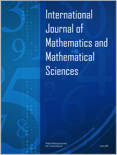
INTERNATIONAL JOURNAL OF MATHEMATICS AND MATHEMATICAL SCIENCES
Advancing mathematical frontiers since 1978.INTERNATIONAL JOURNAL OF MATHEMATICS AND MATHEMATICAL SCIENCES is a distinguished peer-reviewed journal published by HINDAWI LTD, dedicated to advancing the field of mathematics and its various applications. Since its inception in 1978, the journal has been committed to open access, ensuring that research is freely available to all, thereby fostering greater collaboration and dissemination of knowledge. With an impressive Q3 ranking in the Mathematics (miscellaneous) category and a notable Scopus rank in the 72nd percentile, this journal is a vital resource for researchers, professionals, and students. The journal covers a wide range of topics in mathematics, from theoretical explorations to applied methodologies, and it continues to serve as a platform for significant contributions in this evolving discipline. Its continuous publication from 1978 to present reflects its enduring relevance and impact in the mathematical sciences community.
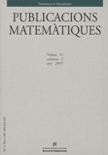
PUBLICACIONS MATEMATIQUES
Fostering Global Dialogue in MathematicsPUBLICACIONS MATEMATIQUES is a prestigious academic journal published by Universitat Autònoma de Barcelona, specializing in the diverse field of mathematics and its applications. With an esteemed Q1 ranking in Mathematics (miscellaneous) for 2023, this journal holds a significant position in the mathematical community, reflecting a commitment to high-quality research that spans both theoretical and practical aspects of mathematics. Although it operates without an Open Access model, it remains accessible to a global audience, featuring contributions that range from pure mathematical theories to interdisciplinary applications. Based in Spain, its influence and reach extend internationally, making it a vital resource for researchers, professionals, and students alike who seek to stay informed and engaged with cutting-edge developments in mathematics. The journal's continuous publication since 2002 further underscores its role in advancing mathematical research and fostering scholarly dialogue.

AIMS Mathematics
Empowering researchers with high-quality studies in mathematics.AIMS Mathematics, published by the American Institute of Mathematical Sciences (AIMS), is a premier open-access journal that has been providing a platform for innovative research since its inception in 2016. With a keen focus on diverse areas within the field of mathematics, this journal aims to disseminate high-quality studies that cater to both theoretical and applied aspects of mathematics. As evidenced by its impressive Scopus rank of 52 out of 399 in the category of General Mathematics, placing it in the 87th percentile, AIMS Mathematics stands as a significant contributor to the academic discourse in this discipline. The journal operates under Q2 in Mathematics (miscellaneous) for its 2023 category quartiles, reflecting its rigorous peer-reviewed process and substantial impact on current mathematical research. Accessible since its launch, the journal's open-access model ensures that researchers, professionals, and students alike can easily retrieve insights and advancements in mathematics, fostering collaboration and the advancement of knowledge globally.
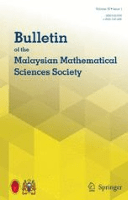
Bulletin of the Malaysian Mathematical Sciences Society
Bridging Theory and Application in Mathematical SciencesThe Bulletin of the Malaysian Mathematical Sciences Society, published by SPRINGER NATURE, is a prominent academic journal dedicated to advancing the field of mathematics. With an ISSN of 0126-6705 and an E-ISSN of 2180-4206, the journal has established itself as a vital resource for researchers, professionals, and students alike. Based in Singapore, it boasts an impressive Q2 ranking in the miscellaneous mathematics category for 2023, alongside a notable position of 90th out of 399 in the general mathematics Scopus rankings, placing it in the 77th percentile. The Bulletin serves to disseminate innovative research findings, foster mathematical dialogue, and promote collaboration among the global mathematical community, with coverage ranging from theoretical frameworks to practical applications. Readers can expect an engaging mix of original research articles, reviews, and communications that contribute significantly to the evolving landscape of mathematical sciences.

Lobachevskii Journal of Mathematics
Elevating Mathematical Discourse Across the GlobeLobachevskii Journal of Mathematics is a distinguished academic journal published by MAIK NAUKA/INTERPERIODICA/SPRINGER, dedicated to advancing research in the diverse field of mathematics. With an ISSN of 1995-0802 and an E-ISSN of 1818-9962, it has been a vital resource for scholars since its inception in 1999. Recognized for its contributions to the field, the journal proudly holds a Q2 ranking in the 2023 Mathematics (miscellaneous) category, placing it among the top half of its peers in Scopus, with a rank of 174 out of 399 and a 56th percentile standing. While currently not classified as an open-access journal, it effectively reaches a global audience through comprehensive dissemination of innovative mathematical research until 2024. Researchers, professionals, and students alike will find the Lobachevskii Journal a significant platform for the latest developments and theories in general mathematics, fostering an environment of scholarly exchange and growth.

BOLETIN DE LA SOCIEDAD MATEMATICA MEXICANA
Advancing Mathematical Discourse GloballyBOLETIN DE LA SOCIEDAD MATEMATICA MEXICANA, published by Springer International Publishing AG, is a pivotal journal in the field of mathematics, particularly recognized for its contributions to the miscellaneous mathematics category, holding a commendable Q2 ranking as of 2023. With an ISSN of 1405-213X and an E-ISSN of 2296-4495, the journal serves as a platform for disseminating high-quality research and innovations from both national and international scholars. Operating from Switzerland, the journal encompasses a broad range of topics within mathematics, supporting the development and communication of mathematical knowledge. Although it is not open access, it remains a respected source for researchers, professionals, and students seeking to deepen their understanding of mathematical concepts and applications. Published continuously and rigorously since its converged years, BOLETIN DE LA SOCIEDAD MATEMATICA MEXICANA plays a crucial role in advancing mathematical discourse and collaboration across disciplines.